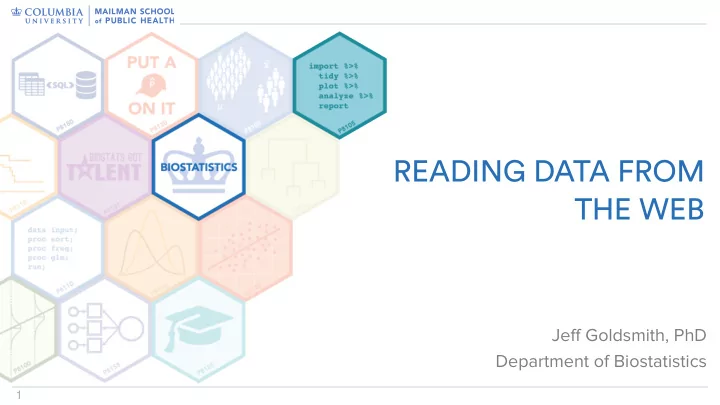

READING DATA FROM THE WEB Jeff Goldsmith, PhD Department of Biostatistics � 1
Two major paths • There’s data included as content on a webpage, and you want to “scrape” those data – Table from Wikipedia – Reviews from Amazon – Cast and characters on IMBD • There’s a dedicated server holding data in a relatively usable form, and you want to ask for those data – Open NYC data – Data.gov – Star Wars API � 2
Scraping web content • Webpages combine HTML (content) and CSS (styling) to produce what you see • When you retrieve the HTML for a page with data you want, you’ve retrieved the data • Also you have a lot of other stuff • Challenge is extracting what you want from the HTML � 3
https://github.com/ropensci/user2016-tutorial Garrett Grolemund, “Extracting data from the web” � 4
https://github.com/ropensci/user2016-tutorial Garrett Grolemund, “Extracting data from the web” � 5
CSS Selectors • Because CSS controls appearance, CSS identifiers appear throughout HTML code • HTML elements you care about frequently have unique identifiers • Extracting what you want from HTML is often a question of specifying an appropriate CSS Selector � 6
Find the CSS Selector • Selector Gadget is the most common tool for finding the right CSS selector on a page – In a browser, go to the page you care about – Launch the Selector Gadget – Click on things you want – Unclick things you don’t – Iterate until only what you want is highlighted – Copy the CSS Selector Inspector Gadget � 7
Scraping data into R rvest facilitates web scraping • • Workflow is: – Download HTML using read_html() – Extract nodes using html_nodes() and your CSS Selector – Extract content from nodes using html_text() , html_table() , etc � 8
APIs • In contrast to scraping, A pplication P rogramming I nterfaces provide a way to communicate with software • Web APIs may give you a way to request specific data from a server • Web APIs aren’t uniform – The Star Wars API is different from the NYC Open Data API • This means that what is returned by one API will differ from what is returned by another API � 9
Getting data into R • Web APIs are mostly accessible using HTTP (the same protocol that’s used to serve up web pages) httr contains a collection of tools for constructing HTTP requests • • We’ll focus on GET, which retrieves information from a specified URL – You can refine your HTTP request with query parameters if the API makes them available � 10
API data formats • In “lucky” cases, you can request a CSV from an API – Sometimes you could download this by clicking a link on a webpage, but ### I went to <website> and clicked “download” isn’t reproducible • In more general cases, you’ll get J ava S cript O bject N otation (JSON) – JSON files can be parsed in R using jsonlite � 11
Real talk about web data • Data from the web is messy • It will frequently take a lot of work to figure out – How to get what you want – How to tidy it once you have it � 12
Recommend
More recommend